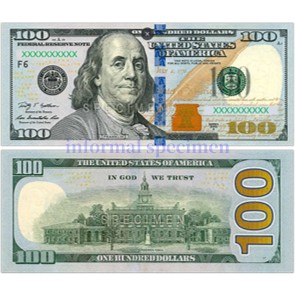Standard Note Size
About Standard Note Size
How are the standard sizes of note determined in various countries ?
1. Historical Legacy and Tradition.
Origin: Many note sizes originated with the historical paper sizes available or the dimensions of older, hand-written financial instruments. The size was often designed to feel substantial and valuable.
Example: The US Dollar. As previously discussed, the US standardized its size in 1928, but that size was based on the existing, smaller-sized notes that had been in use for decades prior. Changing this established size is now nearly impossible due to the embedded infrastructure (ATMs, vending machines, etc.).
2. Human Factors and Ergonomics (A Primary Driver).
This is arguably the most important modern factor. Banknotes must be easy for people to use.
Differentiation by Touch: For the visually impaired, varying sizes are crucial. Most countries use a graduated size system, where the higher the denomination, the larger the note. This allows people to distinguish between bills without having to see them. This is often a legal requirement under accessibility laws and the UN Convention on the Rights of Persons with
Ease of Handling: The notes must be large enough to handle easily but small enough to fit comfortably in a wallet or pocket. The aspect ratio (width-to-height) is often designed to feel pleasant in the hand and to be easy to count and fold.
3. Technical and Production Efficiency.
Sheet Sizes: Banknotes are printed on large, high-security paper sheets. The dimensions of individual notes are meticulously calculated to maximize the number of notes that can be printed per sheet (e.g., 32, 45, or 50 notes per sheet) with minimal waste. The size is a function of the sheet size and the cutting layout.
Machine Processing: The banking system relies on high-speed machines for sorting, counting, and authentication. A standardized, precise size within a series is non-negotiable for this automated processing. The machinery is built to the note's specifications.
4. Security Considerations.
Space for Features: The note must be large enough to incorporate complex security features without making them look cluttered. These include watermarks, security threads, holographic stripes, color-shifting ink, and microprinting.
Consistency: Any deviation in size from the official standard is a immediate red flag for a counterfeit note. Automated machines are calibrated to detect even millimeter-scale variations.
5. Regional Harmonization.
A powerful trend, especially in multi-national economic unions.
The Euro (€): The most famous example. When the euro was introduced, its banknotes were deliberately designed with a harmonized size system. Each denomination has a unique, graduated size and dominant color, making it easy for hundreds of millions of people across 20 countries to recognize and use them. This was a conscious, top-down decision to create a unified currency identity and ensure accessibility.
Eastern Caribbean Dollar (XCD) and the Central African CFA Franc (XAF) are other examples of currencies used across multiple nations with standardized note sizes.
6. Regional Harmonization.
The global shift from paper to polymer (plastic) notes has introduced new flexibility but also reinforced standardization.
Durability: Polymer notes are more durable, meaning the size remains consistent for a longer period throughout the note's lifespan. A paper note can shrink or expand slightly with moisture.
Windowed Features: Polymer allows for clear transparent windows, which are a major security feature. The size must accommodate these windows in a consistent location.




